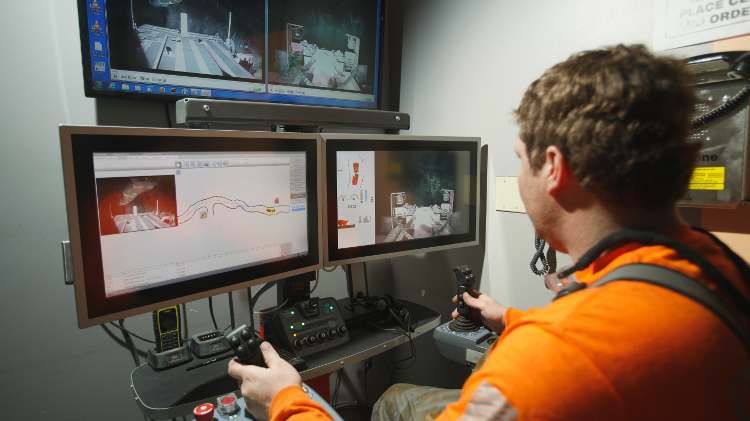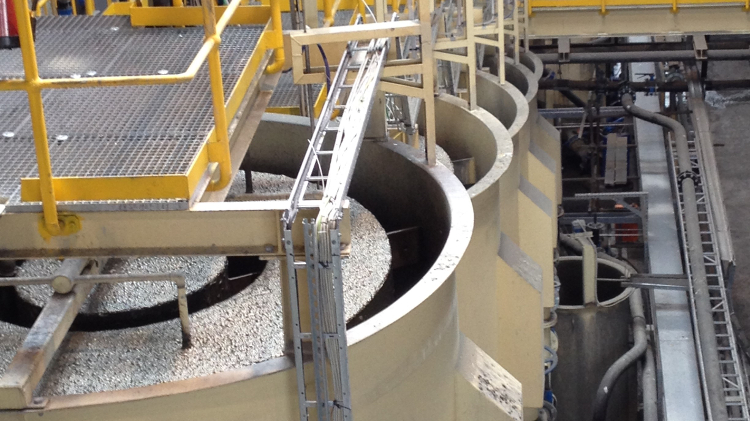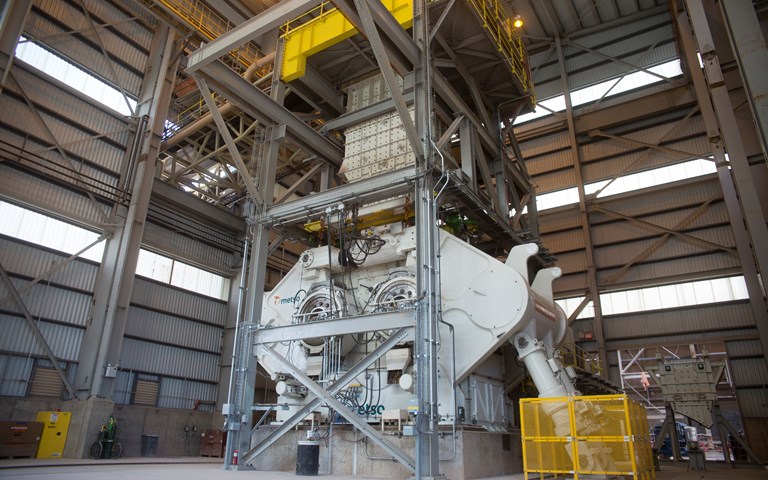Metso developed its HRC 3000 high pressure grinding roll (HPGR) in partnership with Freeport-McMoRan to meet the needs of the miner’s 63,500-tonne-per-day expansion of the Morenci mine’s Metcalf concentrator. Courtesy of Metso
Major design breakthroughs by Metso Minerals in high pressure grinding roll (HPGR) technology at Freeport-McMoRan Inc’s (FCX) Morenci open-pit mine in Arizona have resulted not only in the world’s largest HPGR in operation – the HRC 3000 – but also in significant progress overcoming some of the technology’s greatest challenges. The HRC 3000 is the centerpiece of FCX’s 63,500-tonne-per-day (tpd) expansion of the Morenci mine’s concentrator capacity. The old Metcalf concentrator building, decommissioned in 1996, was repurposed and began operating in May 2014, increasing metal production by an average of 265 million pounds of copper annually.
FCX chose an HPGR over a SAG mill for its expansion because the technology, which crushes ore between two cylinders – or rolls – is about 30 to 50 per cent more efficient than SAG mills.
As well, “the HPGR has the ability to vary the operating speed to match tonnage demands,” said Victoria Herman, product manager of mining HRC High Pressure Grinding Rolls for Metso. “The operating pressure can also be adjusted to handle changing ore conditions.”
There is a catch, though. HPGR technology usually comes with its own set of problems that can result in unscheduled downtime and decreased crushing efficiency, which can eat away at the energy savings.
In large-size operations such as Metcalf, traditional HPGR technology poses an additional problem. The equipment for conventional designs is simply too small to handle such tonnage. The only solution prior to Metso’s HRC 3000 design for the Metcalf concentrator would have been multiple lines. “This increases the amount of ancillary equipment needed,” said Herman.
So Metso and FCX set out to design an HPGR that met the capacity needs for Metcalf. The first step Metso took was to identify the inherent design problems in the existing technology.
Skewing
One design issue was tire skewing, a condition where the axes of the tires that turn the cylinders do not stay parallel due to uneven feed distribution. Rather than adjusting existing designs to prevent skewing, Metso went back to the drawing board and came up with an entirely new HPGR frame, which the company called the Arch-frame. “Traditional HPGRs try to avoid tire skewing by using the hydraulic cylinders,” said Herman. “However, this is often ineffective and the machine trips if the misalignment is too great.”
The idea for the Arch-frame came from the age-old nutcracker, which uses mechanical leverage to increase the crushing force. “Metso’s Arch-frame absorbs unbalanced loads by connecting both bearings with a tube,” said Herman. “This assembly then pivots in the base frame. By preventing skewing, downtime caused by skewing is eliminated.”
The edge effect
One of the most significant challenges for Metso was to combat what is known as the edge effect. “We know edge effect, or the reduction of comminution at the edges of the tires, in traditional HPGRs limits the energy savings,” said Herman.
Because the Arch-frame minimizes skewing, it is possible to use bolt-on flanges rather than traditional cheek plates. Using a lab scale HPGR, Metso performed tests with tires fitted with pressure sensors. The pressure profile of traditional cheek plates and flanges was compared. The results were significant. Unlike traditional cheek plates, the pressure profile of the flanges were nearly flat. Subsequently, comprehensive testing at a 50-tph pilot plant showed that flanges reduce the edge effect to less than five per cent, compared to 15 per cent for cheek plates.
“On pilot plant trials, we performed side by side comparisons and saw an increase in specific throughput up to 30 per cent and a decrease in the circulating load by an average of 24 per cent,” said Herman. “This indicates that the flanges are helping to both pull in material and more effectively crush it.”
But that was not the only area where the new design outdid the traditional stationary cheek plate: “The flanges, by providing a more even pressure distribution across the width of the tires, provide a longer wear life,” said Herman. “Currently the tires in service at the Metcalf concentrator are projected to exceed 16,000 hours.”
Pilot project
Satisfied with their results in the lab, Metso then built a prototype unit for its new design, and did further tests at a quarry in Brazil. By 2012, the company was confident enough with the results to move the unit to the Morenci site. There, Metso and FCX conducted 114 process surveys under various circuit conditions, and validated the design. Among the challenges they tested were tramp metal and oversized ore because these are especially hard on HPGRs as they increase tire wear and stud breakage. In fact, the first tire used at the pilot plant was populated with four different stud types to identify which were more wear resistant. To protect the tire edges from wear, they bolted carbide-edge blocks on the tires, which can be replaced as needed with minimal downtime.
From pilot to full plant
It took Metso and FCX some four years to complete the massive undertaking from design concept to building the full HRC 3000 at Metcalf. The system has tires that are three metres in diameter by two metres wide. It weighs more than 900 tonnes fully assembled and is 15.2 metres tall. Each Arch-frame alone weighs over 75 tonnes, or 270 tonnes when complete with tire, shaft and bearings. Its large components were manufactured across the world, including in South Korea, China, Germany, Holland, Finland, the United States, and Canada. With 11,400 kilowatts of installed power and a maximum capacity of 5,900 tonnes per hour, it has twice the capacity of other HPGRs currently in operation.
Three years ago FLSmidth added a similarly sized design to its lineup of HPGRs, with advanced roll skew controls and design features to make removal of the three-metre by two-metre rolls easier for the maintenance of large parts. However, the turn in the market has made the super-sized rolls a tough sell, said Joe Dziedzina, FLSmidth’s global product manager for HPGR technology. “We can all assume that mining will bounce back one day, and when it does we fully expect HPGRs, and especially large HPGRs, to be a key product in large concentrators just as the industry trends indicated before the downturn.” Likewise, ThyssenKrupp offers an HPGR with three-metre by two-metre rolls, and, according to Torben Beckman, the company’s industrial solutions media relations head, “for special ongoing projects we have bigger [HPGRs] ready on the drawing board.”
The HRC 3000 includes an integrated tramp bypass system, which rapidly opens the gap between the tires to allow an uncrushable object to pass through when detected in the feed. The HRC 3000 also features a hydraulic system that controls everything from the hydraulics to the main cylinders, rod lubrication, stabilizing cylinders and the oil cooling/conditioning circuit.
FCX and Metso continue to develop the HRC 3000, particularly in terms of maximizing the life of the edge blocks and flanges.
The implications of this project for HPGR technology are significant.
“Reducing edge effect has major implications for the design and operation of comminution circuits,” said Herman. “In closed circuit applications the increased breakage rates provide higher energy efficiency by reducing circulating loads and potentially decreasing the size of ancillary equipment. Alternately, the increased breakage rates could allow for a finer product on the HPGR circuit which decreases the size of downstream equipment.”




